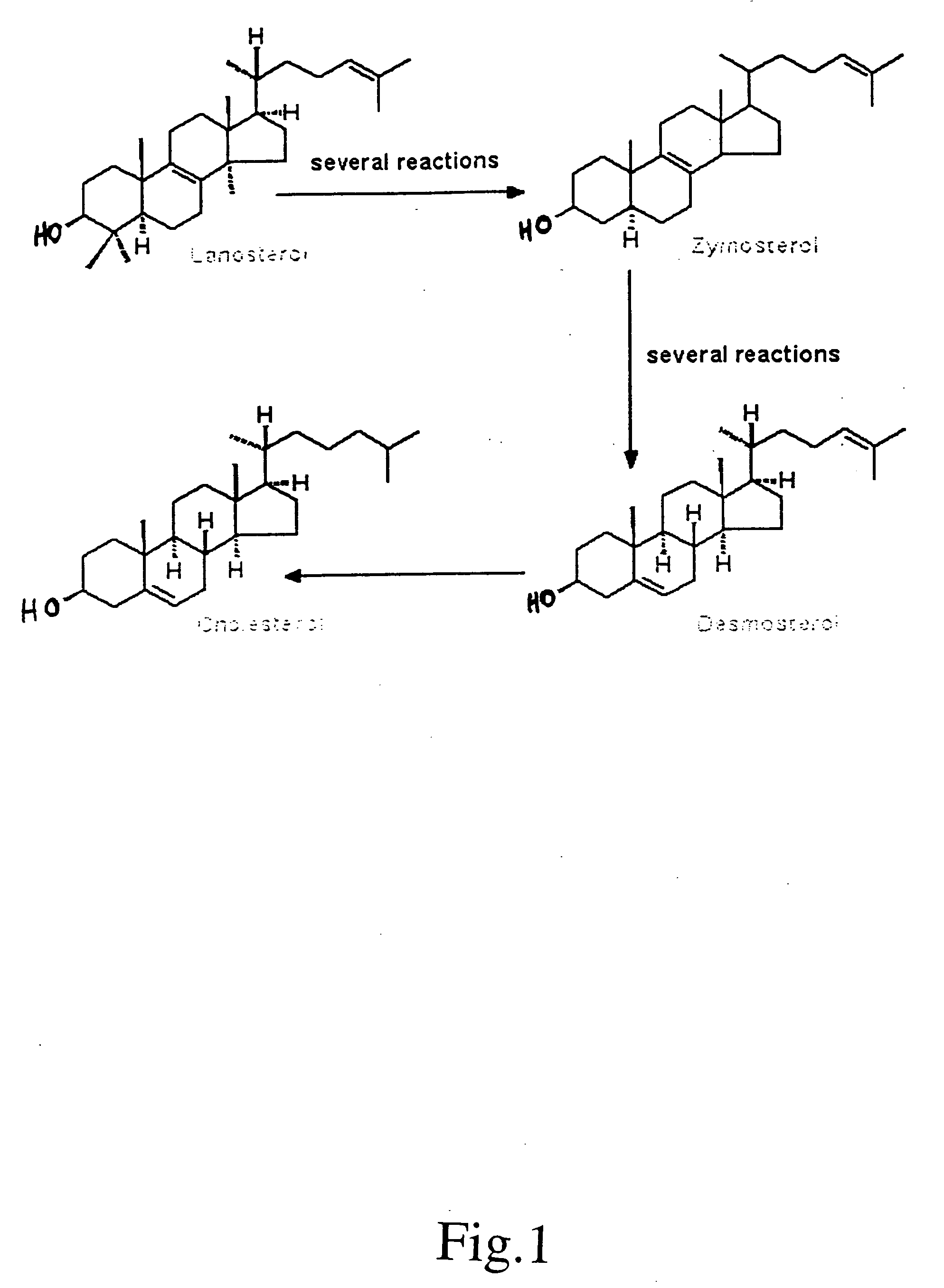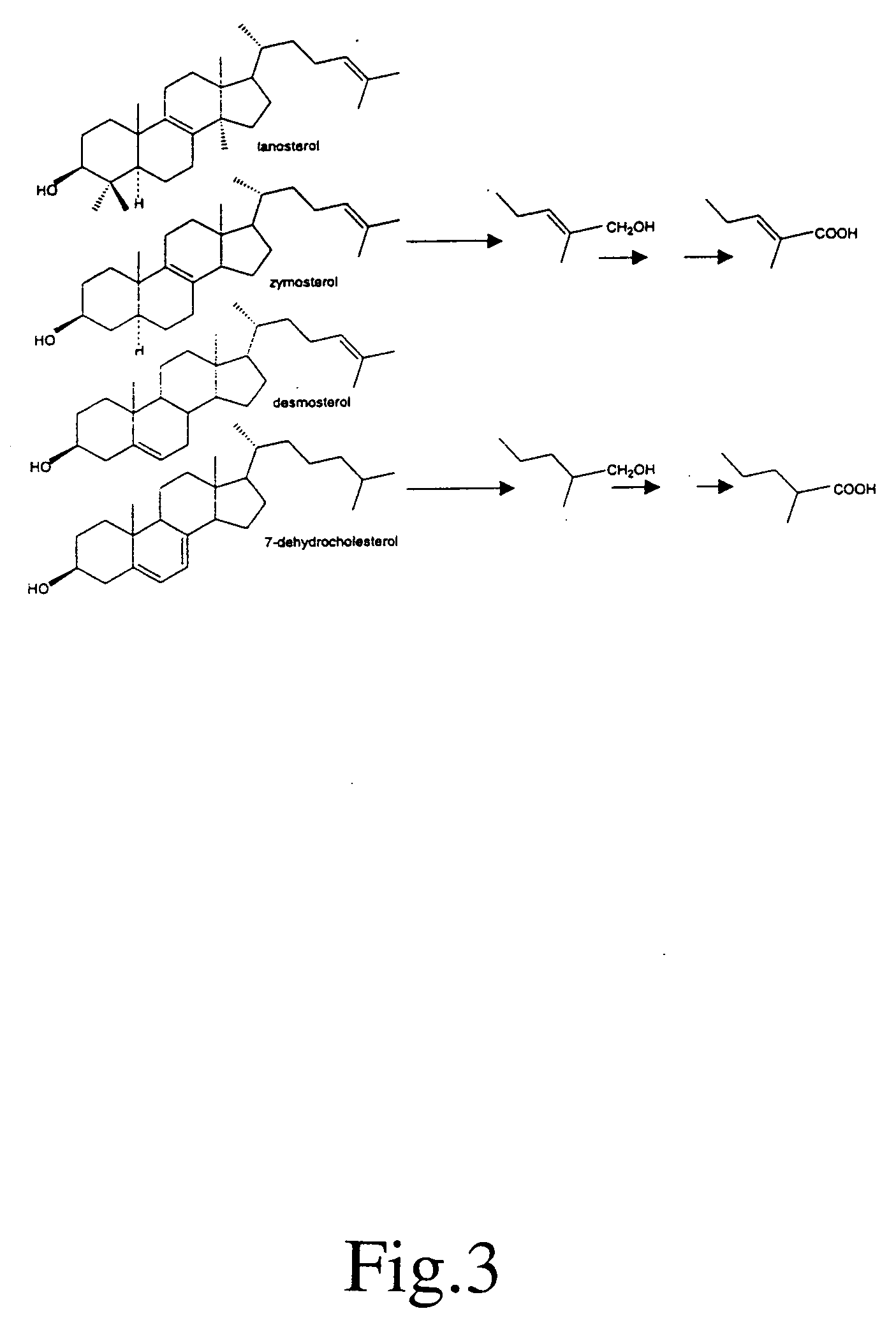Novel class of sterol ligands and their uses in regulation of cholesterol and gene expression
a technology of sterol ligands and gene expression, applied in the field of oxysteroid hormones and oxysteroid hormones, can solve problems such as thrombosis and infarction, and achieve the effect of modulating oxysteroid activity
- Summary
- Abstract
- Description
- Claims
- Application Information
AI Technical Summary
Benefits of technology
Problems solved by technology
Method used
Image
Examples
example 1
Summary
[0120] A major biologic role of the ubiquitous mitochondrial P 450 enzyme CYP 27A1 is the generation of ligands such as 27-hydroxycholesterol and 3β-hydroxy-5-cholestenoic acid, which regulate the expression of nuclear receptors that govern many aspects of cholesterol homeostasis. We now report that sterol intermediates in cholesterol synthesis, beginning with the initial post-cyclization sterol, lanosterol, continuing with zymosterol, and ending with desmosterol are also substrates for the enzyme. Using the human enzyme expressed in E. Coli, we characterized the retention times and major mass fragments of these novel metabolites.
[0121] Although sequestration of the enzyme in the inner mitochondrial membrane and normal subcellular organization may restrict the proportion of these and other intermediates in cholesterol synthesis that undergo side chain oxidation, disruption of compartmentalization can bypass cholesterol as the end product and give rise to potent ligands tha...
example 2
[0154] The endoplasmic reticulum (ER) enzyme 3-hydroxy-3-methylglutaryl-CoA (HMG CoA) reductase produces mevalonate, a crucial intermediate in the synthesis of cholesterol and nonsterol isoprenoids. Mevalonate is converted to sterols and to other products, including the farnesyl and geranylgeranyl groups attached to proteins, directing them to membranes. HMG CoA reductase is subject to tight regulation by a multivalent feedback mechanism mediated by nonsterol and sterol end products of mevalonate metabolism. Excess sterols promote ubiquitination and subsequent degradation of reductase as part of this negative regulation feedback. Feedback control of cholesterol synthesis is mediated, in part, by sterol-induced binding of HMG CoA reductase to Insig proteins in the ER (Sever, N et al (2003) J Biol Chem 278(52):52479-52490). Binding leads to ubiquitination and proteosomal degradation of reductase (Song, B-L and DeBose-Boyd R A (2004) J Biol Chem 279(27):28798-28806).
[0155] It was dete...
example 3
Biologic Effect of 27-hydroxylation of 7-ketocholesterol
[0156] The knowledge that 7-ketocholesterol normally circulates in human plasma (1), accumulates in atheroma (2-5), and perhaps other tissues, together with data that it is highly toxic in cell culture (6-9) has led to the concept that it may have a pathogenetic role in the development of age-related atheroma. More recently, studies by Rodriguez et al (10) have linked 7-ketocholesterol to cytotoxicity in retinal pigment epithelial cells and implicated 7-ketocholesterol as a cause of retinal pigment epithelial injury leading to macular degeneration.
[0157] Macular degeneration, often called AMD or ARMD (for age-related macular degeneration), is the leading cause of vision loss and blindness in Americans aged 65 and older. Because older people represent an increasingly larger percentage of the general population, vision loss associated with AMD is a growing problem. AMD is a degenerative condition of the macula, which is the par...
PUM
| Property | Measurement | Unit |
|---|---|---|
| Time | aaaaa | aaaaa |
| Time | aaaaa | aaaaa |
| Time | aaaaa | aaaaa |
Abstract
Description
Claims
Application Information
 Login to View More
Login to View More - R&D
- Intellectual Property
- Life Sciences
- Materials
- Tech Scout
- Unparalleled Data Quality
- Higher Quality Content
- 60% Fewer Hallucinations
Browse by: Latest US Patents, China's latest patents, Technical Efficacy Thesaurus, Application Domain, Technology Topic, Popular Technical Reports.
© 2025 PatSnap. All rights reserved.Legal|Privacy policy|Modern Slavery Act Transparency Statement|Sitemap|About US| Contact US: help@patsnap.com



